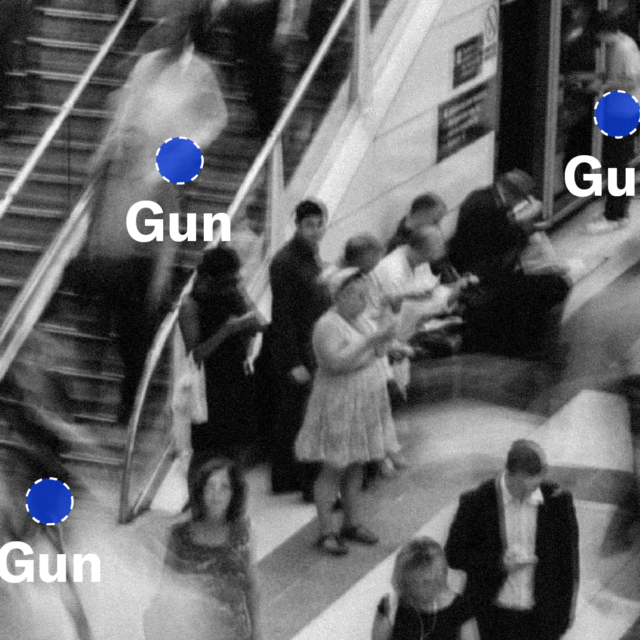Introduction
Gun homicides and assaults occur at high rates within cities, posing notable risks to public safety. In cities, gun violence also disproportionately impacts historically underfunded neighborhoods, which reflects and amplifies this country’s long-standing systemic and structural inequities. For decades, community-based organizations have successfully reduced violence by implementing alternative public safety measures that are locally driven and informed by data. Often referred to as violence intervention programs, these strategies have expanded greatly over the years and include street outreach, group violence intervention, crime prevention through environmental design, hospital-based violence intervention programs, safe passage programs, and cognitive behavioral therapy.
Strategies
Street outreach programs employ a public health approach to violence intervention, beginning with the premise that gun violence is like a contagious disease, the spread of which can be interrupted.1Jeffrey A. Butts et al., “Cure Violence: A Public Health Model to Reduce Gun Violence,” Annual Review of Public Health 36, no. 1 (2015): 39–53, https://doi.org/10.1146/annurev-publhealth-031914-122509. To do so, street outreach organizations provide both immediate crisis response services and long-term stabilization support to individuals and communities affected by gun violence. Street outreach programs deploy violence interrupters who help prevent shootings by identifying and immediately mediating conflicts in a community and working with individuals most at risk. Often these interrupters are former members of street groups who have credibility when speaking to at-risk individuals. Street outreach evaluations reveal mixed impacts on gun/violence, with some sites experiencing significant improvements. A 2017 evaluation of Cure Violence in two New York City neighborhoods found that South Bronx site was associated with significant declines in gun injuries (37%) and shooting victimizations (63%), compared to a matched neighborhood. In East New York, gun injuries declined (50%) as well.2Sheyla A. Delgado et al., “The Effects of Cure Violence in the South Bronx and East New York, Brooklyn,” in Denormalizing Violence (New York: John Jay College of Criminal Justice, Research and Evaluation Center, 2017), https://johnjayrec.nyc/2017/10/02/cvinsobronxeastny/.
Community-driven crime prevention through environmental design (CPTED) is a long-term gun violence reduction strategy centered on a multi-disciplinary approach of crime prevention that uses urban and architectural design and the management of built and natural environments.3Paul Michael Cozens, Greg Saville, and David Hillier, “Crime Prevention through Environmental Design (CPTED): A Review and Modern Bibliography,” Property Management 23, no. 5 (January 1, 2005): 328–56, https://doi.org/10.1108/02637470510631483. By investing in a community’s physical environment and creating spaces in which community members feel safe, cities can discourage and reduce gun violence. A 2018 randomized control trial of lot restoration in Philadelphia found significant reductions in crime and gun assaults (-9.2% and -5.8%, respectively) over a three year period, without displacing crime. Simply cleaning (rather than greening) vacant lots in neighborhoods below the poverty line yielded the most dramatic reductions in crime and gun assaults (-13.3% and 29.1%, respectively).4Charles C. Branas et al., “Citywide Cluster Randomized Trial to Restore Blighted Vacant Land and Its Effects on Violence, Crime, and Fear,” Proceedings of the National Academy of Sciences of the United States of America 115, no. 12 (2018): 2946–51. CPTED research generally suggests that environmental remediation strategies result in localized reductions in crime and gun violence.
Hospital-Based Violence Intervention Programs (HVIPs) are based on the premise that there is a unique window of opportunity to engage victims of violence and prevent retaliation in the immediate aftermath of a traumatic injury.5The Health Alliance for Violence Intervention, “What Is a Hospital-Based Violence Intervention Program (HVIP)?,” accessed September 14, 2020, https://www.thehavi.org/what-is-an-hvip. As such, HVIPs are typically located in trauma centers and emergency departments, where service providers partner with patients and families immediately after and during the months that follow the injury to ensure that they have the support and resources necessary to heal and remain safe. San Francisco’s HVIP, the Wraparound Project, demonstrated a six-year violent reinjury rate of 4.9 percent (2005-2014), compared to a 8.4 percent historical control of violently injured patients prior to the program’s implementation (2000-2005).6Catherine Juillard et al., “A Decade of Hospital-Based Violence Intervention: Benefits and Shortcomings,” Journal of Trauma and Acute Care Surgery 81, no. 6 (2016): 1156–61, https://doi.org/10.1097/TA.0000000000001261.
Safe Passage programs provide safe routes to and from schools to reduce student exposure to gun violence.7Everytown for Gun Safety Support Fund, “The Impact of Gun Violence on Children and Teens,” May 29, 2019, https://everytownresearch.org/report/the-impact-of-gun-violence-on-children-and-teens/. To achieve this goal, schools, law enforcement, and communities collaboratively establish protocols and procedures that are both community- and resource-informed, tailored to popular modes of travel as well as student arrival and dismissal times. In Chicago, safe passage protocols and procedures have been in effect since 2010 and have had substantial effects. A longitudinal study analyzing data from 2005–2016 found that following the program’s implementation, incidences of crime along these routes experienced an average reduction of 28 percent for simple assault and battery and a 32 percent reduction for aggravated assault and battery. Furthermore, overall weekday criminal incidents on school grounds have decreased by an average of 39 percent per year.8Viviane Sanfelice, “Are Safe Routes Effective? Assessing the Effects of Chicago’s Safe Passage Program on Local Crimes,” Journal of Economic Behavior & Organization 164 (August 2019): 357–73, https://doi.org/10.1016/j.jebo.2019.06.013.
Cognitive behavioral therapy (CBT) is a therapeutic approach through which service providers work with individuals and/or groups to change behaviors by shifting current ways of thinking and perceiving situations. CBT is a longstanding, evidence-based strategy for reducing criminal behaviors across multiple populations (e.g., young, old, community-based, and incarcerated) and in a variety of settings (e.g., therapists’ offices, schools, and street corners).9Stefan Hofman, Anu Asnaani, Imke Vonk, Alice Sawyer, and Alicia Fang, “The Efficacy of Cognitive Behavioral Therapy: A Review of Meta-Analyses,” Cognitive Therapy Research 36 (2012): 427–440, https://doi.org/10.1007/s10608-012-9476-1. For this reason, CBT is present in many gun violence intervention programs. One prominent example is Advance Peace, an emerging program that offers individuals at high risk for gun violence with community-based CBT, mentorship, case management, substance abuse treatment, internships, travel, and stipends.10Angie M. Wolf et al., “Saving Lives: Alternative Approaches to Reducing Gun Violence,” International Journal of Social, Behavioral, Educational, Economic, Business, and Industrial Engineering 9, no. 6 (2015): 2175–83. A 2019 quasi-experimental evaluation of Richmond, California’s Operation Peacemaker program—a key component of Advance Peace—generated mixed results, as the program was associated with both a relatively large (43–55%) reduction in firearm homicides and assaults, and a relatively small (3–16%) increase in non-firearm homicides and assaults six years post intervention.11Ellicott C. Matthay et al., “Firearm and Nonfirearm Violence After Operation Peacemaker Fellowship in Richmond, California, 1996–2016,” American Journal of Public Health 109, no. 11 (2019): 1605–11, https://doi.org/10.2105/AJPH.2019.305288.
Group violence intervention (GVI) programs—also known as focused deterrence programs—center on the belief that violence can be prevented if individuals believe the costs associated with the violence outweigh any potential benefits.12Anthony A. Braga and David L. Weisburd, “The Effects of ‘Pulling Levers’ Focused Deterrence Strategies on Crime,” Campbell Systematic Reviews 8, no. 1 (2012): 1–90, https://doi.org/10.4073/csr.2012.6. These programs target chronic violent offenders—individuals who have been identified by law enforcement, criminal justice data, and community members—and include three sets of intervening actors: law enforcement, community representatives, and social service providers. In essence, high-risk offenders are presented with strict consequences for continued violent behavior, coupled with access to social services and ongoing support from community members, should they choose a different path. A 2019 quasi-experimental study of Oakland Ceasefire found that program-participating gangs were associated with a significant 26 percent reduction in quarterly gang-involved shootings compared to untreated gangs.13Anthony A. Braga et al., “Street Gangs, Gun Violence, and Focused Deterrence: Comparing Place-Based and Group-Based Evaluation Methods to Estimate Direct and Spillover Deterrent Effects,” Journal of Research in Crime and Delinquency 56, no. 4 (July 1, 2019): 524–62, https://doi.org/10.1177/0022427818821716.
Conclusion
Common sense gun laws like background checks for all gun sales play a critical role in ensuring public safety across the country by systematically keeping guns out of the hands of dangerous individuals. But communities facing imminent gun violence crises require immediate and locally driven interventions in addition to larger scale policy reform. Research on violence intervention programs is still emerging as implementation and evaluation resources continue to expand, but already each of the six strategies described above stand out as both community- and evidence-informed. These programs are being sought out by those who are disproportionately impacted and at highest risk of gun violence—and they’re working.
Everytown for Gun Safety Support Fund (Everytown) is committed to expanding awareness of and access to these community-led violence intervention strategies. Everytown’s City Gun Violence Reduction Insight Portal (CityGRIP), for example, is one tool cities can use to understand which violence intervention strategies might be most appropriate for their own communities’ needs and resources. CityGRIP also allows cities to explore implementation case studies. Since 2018, Everytown for Gun Safety has granted $8 million in support of 74 community-based violence intervention programs implementing promising strategies in more than 57 American cities. To learn more about these strategies, how they work, and Everytown’s investment in community gun violence reduction, please visit the Everytown Community Safety Fund.
Community-based gun violence intervention organizations currently supported by Everytown via the community gun violence grant program:
- Advance Peace (Richmond, Stockton & Sacramento, CA)
- AIM4Peace (Kansas City, MO)
- The Buffalo Peacemakers (Buffalo, NY)
- Detroit Public Safety Foundation – Ceasefire Detroit (Detroit, MI)
- Community Passageways (Seattle, WA)
- Cleveland Peacemakers Alliance (Cleveland, OH)
- Employment Connection (St. Louis, MO)
- Inner City Innovators (West Palm Beach, FL)
- Safe Streets Baltimore (Baltimore, MD)
- No More Red Dots (Louisville, KY)
- People’s Advocacy Institute – Operation Good & Safe Streets (Jackson, MS)
- Paterson Healing Collective (Paterson, NJ)
- Philadelphia CeaseFire (Philadelphia, PA)
- Regional One Health – Rx for Change (Memphis, TN)
- South Pittsburgh Coalition for Peace (Pittsburgh, PA)
- 414Life (Milwaukee, WI)
- Alliance of Concerned Men (Washington, DC)
- California Partnership for Safe Communities (Oakland, CA and multiple cities)
- CHRIS 180 (Atlanta, GA)
- Faith in Action Alabama (Birmingham, AL)
- Gideon’s Army (Nashville, TN)
- Institute for Nonviolence Chicago (Chicago, IL)
- Mothers In Charge – Philadelphia (Philadelphia, PA)
- New Orleans Cure Violence (New Orleans, LA)
- Project L.I.F.E. (Minneapolis, MN)
- Project Longevity (New Haven, Hartford, & Bridgeport, CT)
- ROCA – Baltimore (Baltimore, MD)
- The TraRon Center (Washington, DC)
- YouthAlive! (Oakland, CA)
- YouTurn Omaha (Omaha, NE)
Learn More:
Everytown Research & Policy is a program of Everytown for Gun Safety Support Fund, an independent, non-partisan organization dedicated to understanding and reducing gun violence. Everytown Research & Policy works to do so by conducting methodologically rigorous research, supporting evidence-based policies, and communicating this knowledge to the American public.



